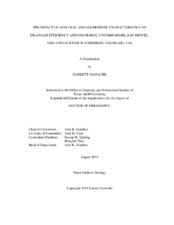| dc.description.abstract | In the western United States, limited availability of fresh water coupled with growing agricultural and urban demands are causing large urban locations to be heavily dependant on montane water resources as supplemental sources of water supply. Unfortunately, montane water resources are delicate and highly dependent upon persistent weather and climatic conditions. With current research indicating dramatic changes resulting from climate warming, water resources in montane areas are approaching excessive liability. The problem of reduced water resources is being
accelerated by the decreasing volume of readily available fresh water and population increasing. Thus, predicting the impact of weather trends and variability on water resources is necessary to ensure that demands for water for irrigation and municipal water supply can be met.
Although snowmelt is the primary hydrologic input to montane streams, other first-order controls affect the spatial variability of the hydrologic response linked to weather phenomena. Spatial differences in geologic and geomorphic controls are likely to have equally significant influences on the response of streamflow, as does the spatial relationship associated with snow accumulation and melt. To understand the hydrologic response related to weather phenomena in montane regions, it is necessary to ask: Do weather phenomena and spatial variations in geology and geomorphology reduce or shift the timing and volume of montane streamflow regimes?
This study focuses on the Uncompahgre, San Miguel and Animas River watersheds, located in the San Juan Mountains of southwestern Colorado. General Least Squares and Weighted Least Squares regression techniques were used to identify changes in the timing and volume of montane streamflow, and determine the extent to which such changes are related to weather phenomena and geologic and geomorphic watershed characteristics. This study suggests that for the selected montane watersheds, streamflow is beginning earlier, peaking earlier and in some cases, lasting longer into the year. It was found that the timing of montane streamflow regimes can be explained by
average monthly maximum and minimum temperatures and average monthly precipitation. It was also determined that site specific relationships between the timing and volume of flow regimes can be sufficiently explained by subbasin drainage area, average basin slope, average basin elevation, percentage of subbasin area above 2,250 m, dominant basin aspect, lithologic rippability, landcover and average annual precipitation. The selected explanatory variables were more successful at describing low streamflows in the summer rather than describing low streamflows in the spring. | en |


